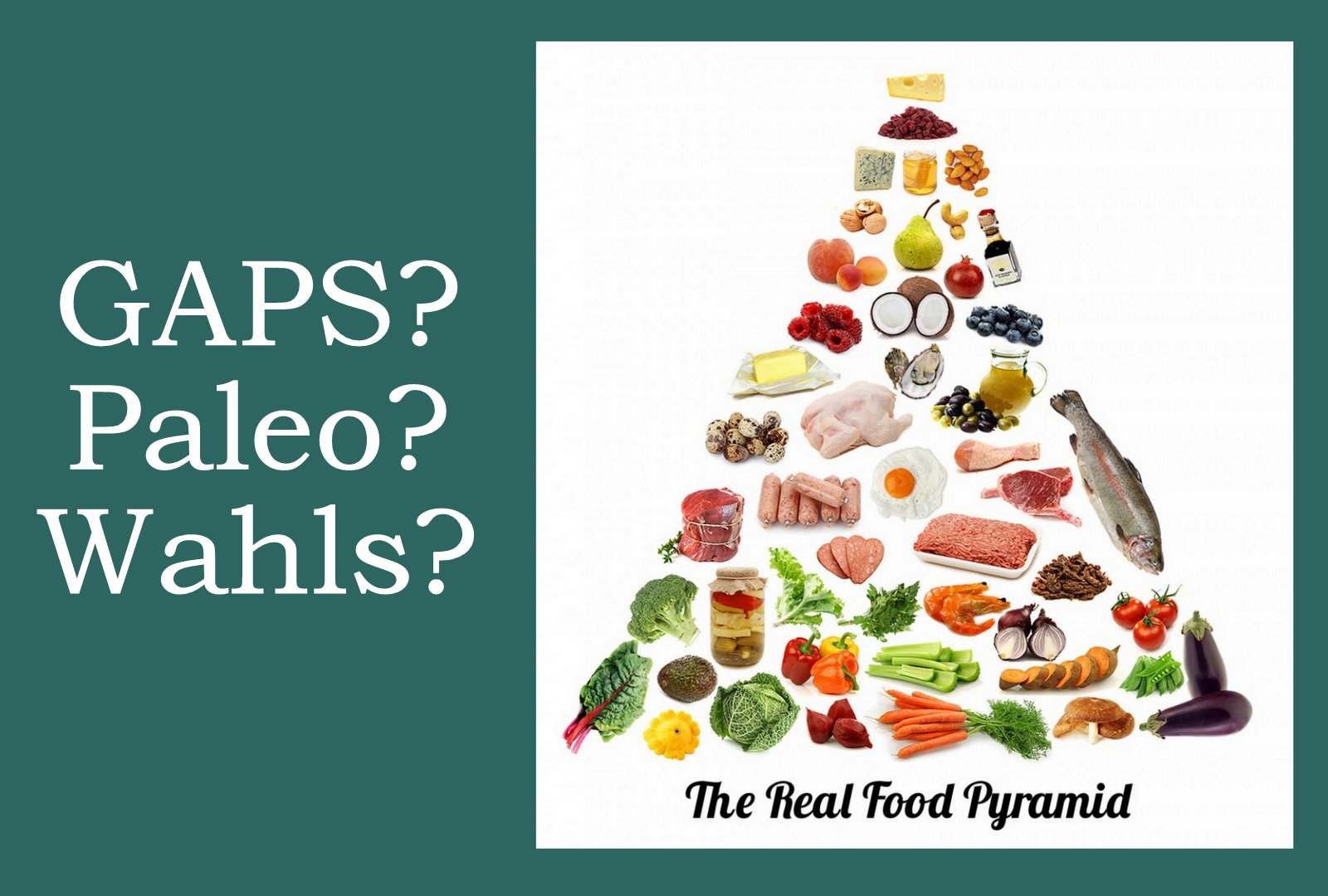
Why These 3?
There are many healing diets, but the three featured on this website are GAPS, Paleo and the Wahls Protocol. I chose these three, because they are well known, have had a great deal of success, and are similar in philosophy. Here’s a breakdown on their origins, similarities and differences:
Origins

Like Gottschall, Campbell-McBride was motivated by parenthood, but her child was autistic. There was a chapter in Gottschall’s book that discussed the gut-brain connection. That intrigued Campbell-McBride, and she implemented a variation of the diet with her son, making a few key changes to the protocol (an emphasis on nutrient-dense foods and the addition of a detox program.) A few years later, he was no longer autistic. She had similar success with other patients in her medical practice, and in 2004, she published GAPS: Gut and Psychology Syndrome. It was designed to help not only autistic children, but people with mental illness as well. After publishing the book and seeing it applied successfully for many health conditions, she expanded her theory to the belief that all autoimmune disorders could be healed through the GAPS Diet as well. The GAPS Diet is divided into two parts: The Introduction Diet and the Full Diet.
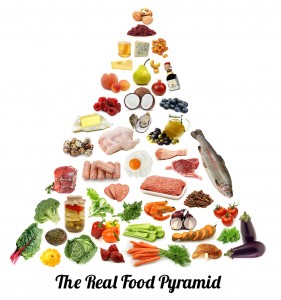
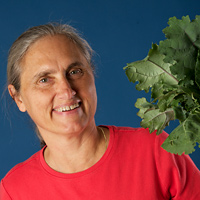
How are the diets the same? Where do they differ?
- All of the diets avoid refined sugar and limit natural sugars. Raw honey is allowed on all of the diets, in small quantities.
- All of the diets avoid packaged and processed foods. This is because these foods almost always contain additives, which are disallowed on the diets. Read the boxes and cans carefully, before buying. I’ve learned that the health food store shelves are filled with products that contain additives, falsely advertised as “natural”. Basically, whole foods are best.
- All of the diets are grain-free. That means no wheat, rice, oats, amaranth, quinoa, millet, barley, buckwheat, rye, spelt or corn (yes, corn’s a grain.) And no foods made with grains (crackers, pasta, breads, cookies, etc.) Here’s a quick link to why. (Note: the Wahls Diet has different levels. The first level is simply gluten-free. The top level is 100% grain-free.)
- All of the diets acknowledge dairy as a common food intolerance. They handle this in different ways. The Wahls Diet eliminates it. The GAPS Diet eliminates it at first, and then reintroduces it slowly to test for tolerance, starting first with ghee, then butter, yogurt, sour cream, kefir, hard cheese and finally cream. The dairy should always be organic, without additives (which often means homemade yogurt and kefir) and ideally raw. This introduction process is designed to take place over many months, with the understanding that some people may never tolerate dairy. Finally, the paleo community debates the use of dairy. Some paleo leaders say to avoid dairy altogether. Others say that if it’s raw and you tolerate it well, it can be a good source of nutrition.
- All of the diets either eliminate or limit legumes (the dried bean family). Here’s why. The Paleo Diet eliminates them altogether. The GAPS Diet allows only three: lentils, split peas and white navy beans (because they have the lowest amount of starch), but they must be soaked or sprouted first. The Wahls Diet slowly transitions people away from legumes.
- All of the diets are soy-free. Here’s why.
- All of the diets focus on the importance of eating enough fat. Did you just do a double-take? After hearing for decades that fat is bad for you, this takes some adjustment. However, it turns out that the villainizing of fat was based on faulty science. Fat is an essential building block for every cell in the body, while simultaneously regulating hormone production and metabolism. In fact, the brain itself is composed of 60% fat. The type of fat is important however, and all of the diets agree on the recommended ones: fish oil, coconut oil, olive oil, palm oil, ghee, animal fats from organic grassfed meats, and the natural fats found in nuts and avocados. In addition, all of the diets care about the balance of omega 3 vs. omega 6 fats, recommending eliminating omega 6 as much as possible, while boosting omega 3, with seafood being the best source of omega 3.
- Starch controversy: Root vegetables vary a lot in their starch content, with cassava being one of the highest and beets being one of the lowest. The GAPS Diet only allows those with the lowest starch content: beets, carrots and winter squash, believing that starch feeds harmful bacteria in the body. The Wahls Protocol recommends people reduce their starch intake, prioritizing non-starchy vegetables. Starch advice in the paleo community varies. Some people advocate no starchy vegetables, and others allow for a large list of “safe starches“, believing that when you restrict starches, you aren’t only starving harmful bacteria but beneficial bacteria as well. Science hasn’t yet proven which theory is correct.
- Eat your veggies. Although non-starchy vegetables are part of all the diets, they’re stressed most highly on the Wahls Diet, where she recommends eating 9 cups of vegetables daily (3 cups leafy greens, 3 cups sulfur-rich veggies, 3 cups colorful veggies). By doing so, you’re feeding your body the micronutrients she identified as being essential to the health of your brain and body. While the Paleo Diet allows an infinite amount of non-starchy vegetables, some people get caught up in the joy of meat-eating and leave the vegetables by the wayside. Wahls tried the Paleo Diet before developing her protocol and while it slowed her decline, her MS didn’t begin to reverse (improve) until she added the 9 cups of vegetables per day. The GAPS Diet uniquely focuses on the fiber content of vegetables. People with digestive difficulties are often prone to either diarrhea or constipation. For those prone to diarrhea, fiber irritates an already inflamed digestive tract. This inflammation can be healed quickly on the GAPS Introduction Diet, where fiber is removed on stage one and slowly reintroduced as symptoms subside. On the GAPS Full Diet, non-starchy vegetables are allowed in infinite quantities.
- All of the diets recommend nutrient-dense foods: such as bone broths, organ meats, egg yolks, and naturally fermented foods.
- All of the diets recommend eating organic vegetables and grassfed meat. Since these are healing diets, the goal is to remove influences that are unhealthy for the body, and that includes pesticides in conventional vegetables, and antibiotics and hormones in conventional meat. If budget constraints prevent you from doing this 100% of the time, here is a list of the most important foods to eat organically.
- The role of detoxification: Both the GAPS Diet and the Wahls Protocol prioritize the diet itself as detoxifying, but also recommend gentle supportive measures such as detox baths, saunas, and removing toxic items from the home. Detoxification isn’t discussed much in the paleo community, except to explain the flu-like symptoms people sometimes experience going from the Standard American Diet to the Paleo Protocol, as their body adjusts to the change.
- All of the diets stress the importance of Vitamin D. Research is showing that the majority of people worldwide are deficient in Vitamin D, and there is a link between this deficiency and the development of autoimmune disease. Our skin is designed to create Vitamin D when exposed to sunlight, but most people spend their day indoors and when outside, cover up with sunscreen which prevents Vitamin D from forming. Very few foods contain Vitamin D, and studies show that Vitamin D supplementation doesn’t always equate to improved health. The best way to get vitamin D is to sunbathe 15-30 minutes daily in the summertime.
- Beyond Diet: The Paleo Movement is a lifestyle that goes beyond diet; its goal is to recapture the health benefits of the lives lived by our ancestors millions of years ago: time outdoors, natural exercise, socialization, time for play, quality sleep, a balanced life. The GAPS Diet focuses primarily on food and detoxification for healing, but she does recommend the health-boosting effects of physical activity in fresh air and swimming in unpolluted natural waters. The Wahls Protocol recommends reducing stress through a variety of means: meditation, exercise, spending time with loved ones, and spending time in nature, as essential supplements to its nutrition program.
- Lifetime vs. Temporary: Both the Paleo and Wahls Diets are designed to be continued for life. The GAPS Diet is unique in that it’s designed to be temporary (average time of 2 years). Its goal is to heal the gut, and once that goal is accomplished, GAPS has a protocol for transitioning off the diet to a wider expanse of foods. That said, she doesn’t recommend returning to the Standard American Diet, which caused the problem in the first place. The goal of all 3 diets is a lifetime of health.
Ready to learn more?

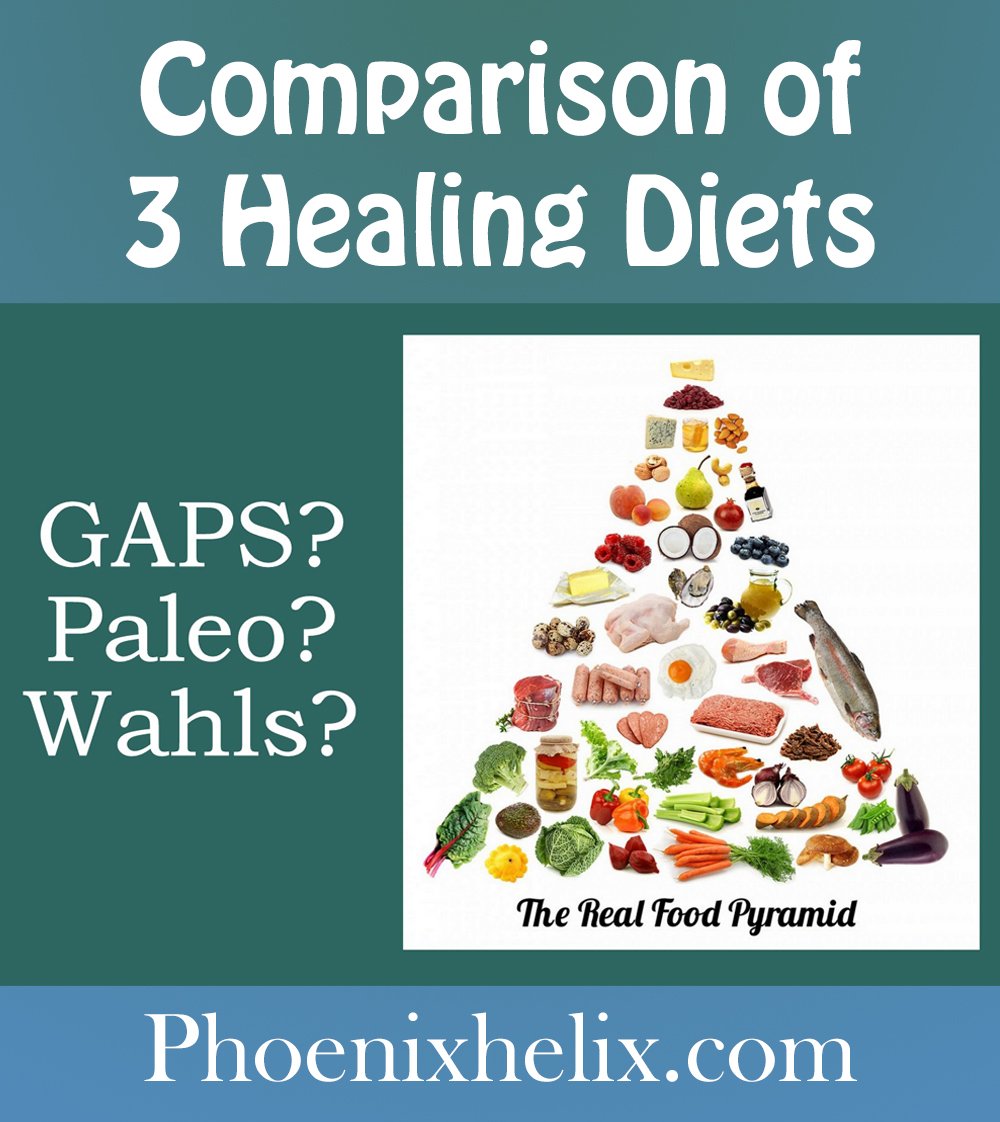



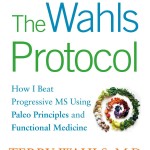
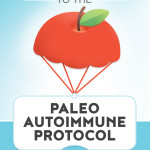


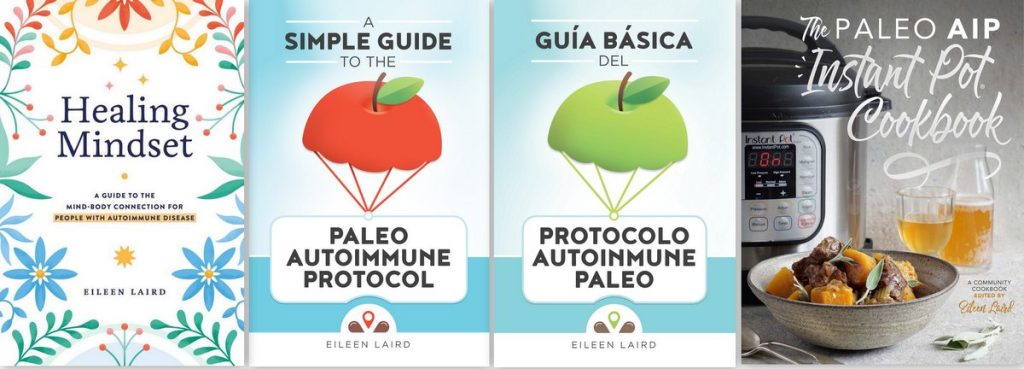
I have spent hours reading through your website over the past several months, and it has been a source of tremendous hope for me, at a time when I’ve often felt hopeless and desperate. Thank you for the amazing amount of work you’ve done and your dedication to helping others — strangers whom you’ve never met.
For the past couple of years, I’ve been seeing a rheumatologist for an inflammatory arthritis condition. As with you and many of your readers, this all seemed to happen suddenly, after being healthy and active my whole life. I have a young daughter, and sometimes I am secretly terrified that I’ll end up completely disabled, with useless and deformed hands.
Anyway, I’ve spent nearly that whole time reading about and trying different dietary approaches to try to manage my symptoms. But I’ve often found myself confused by the conflicting information that I’ve seen as I’ve tried to research what to do:
(1) In the beginning, I tried the AIP diet and was very strict with it. It was difficult because I’m not a great cook, and because my daughter (age 12) is vegetarian. At the time, my primary symptoms were dry eyes and dry mouth, and I noticed no difference, so eventually I went off the diet.
(2) Later, as I developed joint pain, I read numerous articles about how animal protein (of any type) exacerbates joint pain, and reviewed research studies where patients with rheumatoid arthritis improved on a strict vegetarian diet. I read dozens of testimonials by people whose autoimmune conditions healed on this diet. But the recommended protocol (e.g., the MacDougall diet)) was almost literally the opposite of what AIP recommends: a mostly grain-based diet with lots of legumes, etc.
I’ve gotten to the point that I feel a little paralyzed by all the conflicting warnings about food. For example, I’ve never seen a defense of the MacDougall-type diet that addresses how a diet full of lectins, etc., can help heal the gut. And so far I haven’t found an explanation of why an AIP-type diet can help autoimmune issues in light of studies showing that all animal proteins exacerbate inflammation and joint pain. Is the idea that only poor quality animal proteins (such as grain-fed meat. higher in Omega 6) exacerbate inflammation?
I want to try AIP again. It just seems to make sense, and it can’t be a coincidence that so many of the recommended dietary approaches seem to share an emphasis on things like bone broth, high quality animal protein, no grains, no legumes. But now, having read those rheumatoid arthritis studies, I can’t shake the worry that animal protein — no matter the source — may exacerbate the symptoms I already have. I was wondering if you have any thoughts on this, or if you have written on this specific issue already? You’ve given so much and written so much that I hate to ask anything more — but I really trust your knowledge and experience and would be grateful for any thoughts or advice. Thank you, and sorry for such a long message
Hi Lily. The problem with many of the studies about meat is that they are done within the context of a Standard American Diet (i.e. lots of junk food). So, they’re looking a diet filled with burgers, burritos, and fries, not a diet based on high quality meat, seafood, and plenty of vegetables. Here are two articles you might find helpful. The first is by Chris Kresser: https://chriskresser.com/does-red-meat-cause-inflammation/ . The second is by Dr. Sarah Ballantyne: https://www.thepaleomom.com/the-diet-were-meant-to-eat-part-3-how-much-meat-versus-veggies/ . Chris Kresser also has an entire series of articles on the topic “Is Eating Meat Good For You?” – https://chriskresser.com/bibliography/ . I hope that helps! Wishing you wellness, whatever you choose.
Great article…
Thank you!
HI Eileen, I know this is a really old blog, but I’d love your thoughts. I have tried all 3 of these diets for a period of at least 6 months each very intensively. Nothing has moved the dial on my symptoms. Do you think it’s the high histamine and thiol content of these diets??? Have you ever tried out a low histamine/thiol diet for autoimmune paleo?
Please respond if you can.
Thanks,
Lisa
Hi Lisa. Histamine intolerance is an issue for some people, and if you’d like to learn more, I recorded a podcast on that topic: Episode 36. When you get no improvement through dietary changes, it’s time to dig deeper because usually there is something acting as an obstacle to healing. Histamine intolerance is just one possibility. There are many more, and a good functional medicine practitioner should be able to help your prioritize testing based on your health history. You might also be interested in my recent podcast with Andrea Nakayama, where she described how routine bloodwork can give clues to underlying problems. Wishing you wellness!
Hi guys. Diagnosed at 8 years old with autoimmunity. My personal experience has been that working on my diet yielded great results for a while but until I addressed stressful and abusive dynamics in my life, I wasn’t seeing the same relief. I had to distance myself from abusive family and address my emotional stressors to continue healing. It’s all connected IMO and it’s an ongoing journey. Hopefully one day I’ll reintroduce them back into my life, but for now they are part of my elimination list lol!
Hi Ellie, this is so true. Thank you for sharing your experience. I wrote a book on the mind-body connection and autoimmune disease: Healing Mindset. It’s such a big piece! I’ve also had to take distance from someone in my life who wasn’t good for my health. It’s a hard decision, but also an act of self-love.
I started the Wahls protocol diet three weeks ago to help cure my CIDP neuropathy. But for the last week I have been suffering terrible diarrhea. What could be the cause?
Hi Rose. Since the Wahls Protocol is high in vegetables, you might simply be eating more fiber than your body is accustomed to. Cooked vegetables are easier to digest than raw, and starchy veggies tend to help people with a tendency toward diarrhea. I recommend making your goal the lower end of her range – 6 cups daily, and cooked rather than raw with some root veggies in the mix, and see if that helps.
Hi Rose, I am in the process of dealing with CIDP after having been hospitalized 4 times in the past couple of months. I’m wondering if you’ve found the best diet for you?
Hi – My children and I struggle with Lyme (and co-infections) as well as mold poisoning. Because we still frequently get tick bites we are always working with our immunity. You are
Giving me the courage to try AIP as we have had lots of stressors lately. GAPS did wonders for us but we have new sensitivities after new infections. I do want to comment that many symptoms I am reading about in these comments are identical to the ones I experienced in a mold infested home. Most of the nerve pain and hormone imbalances, brain fog and aches left when we evacuated our home. I have seen this happen for multiple people
told they had ms. Also, the migrating joint pain goes away when my Lyme is being treated. I believe Dr. Walhls also had Lyme and I hope this continues to get attention. Thanks so much for all your work!
Thanks for sharing, Kirsten. One thing I do want to clarify is that Dr. Wahls never had Lyme disease. While it can mimic MS symptoms, this is more rare. Most people I know with MS (including Dr. Wahls) find it to be accurate diagnosis, backed up by MRIs showing lesions. However, mold is getting more and more attention. For anyone interested in learning more, here’s a podcast Chris Kresser did on the topic: https://chriskresser.com/how-to-test-your-home-for-mold-with-mike-schrantz/ . Wishing abundant health to you, Kirsten, and your entire family.
Interesting and informative! My gastro doc recommended anti-inflammatory diet after some troubled times, and I left the office with a less than comprehensive handout from Dr. Weil. I did hear the dr mention specific carbohydrates. I’m sort of confused on the nuanced differences and what EXACTLY I should be doing. Currently I’m eating no beef, pork, cheese, etc. It has been rather difficult to know if I am really following the proper diet. Any advice would be helpful!!
Hi Mona. There is a lot of varied dietary advice out there. You are the only who can decide which protocol resonates with you. This website focuses on nutrient-dense paleo healing protocols, all described in the above article. Dr. Weil is not a paleo practitioner, so I imagine his diet is grain-based. One place we all agree is to remove processed foods and sugars from the diet. The next step I recommend for people is removing gluten and dairy, choosing high-quality meat and seafood (organic and grass-fed as opposed to conventional) and eating a wide variety of vegetables. If you want to go fully paleo, this article shows you how. Wishing you wellness, whatever you choose.
Thanks, although I didn’t mention it in my comment, my diet is both gluten and dairy free. I do see that your diet allows cheese and he makes mention of cheese choices as well. I was under the impression that a dairy free diet would exclude all cheese products. What’s the predominant view on that?
Hi Mona. My personal diet is dairy-free. This article is an overview of 3 healing diets, and dairy is discussed in the bulletpoints above. If you have further questions about these diets, I recommend reading the books: (1) The GAPS Diet (2) The Wahls Protocol (3) The Paleo Solution.
Great article! Could you clarify the statement “Vitamin D supplementation is ineffective? ” I wasn’t aware of this and question it. Thanks!
DeeDee, thanks so much for this question. I realize that statement in the article was oversimplified and I’ve corrected it. Research on Vitamin D is showing that supplementation isn’t leading to the health benefits expected, and sometimes oversupplementation is even causing harm. Sunshine remains the ideal way to get the true benefits of Vitamin D. This article will explain in more detail: https://chriskresser.com/vitamin-d-more-is-not-better/
What a great article! I am a Nutritional Therapy Practitioner, and was just prepping for a client when I came across this post! It is very helpful and informative! Thank you very much!
I’m so glad it was helpful, Sarah!
Hi Elaine,
Thank you for all the information here. It’s great to have side by side comparisons. I clicked on the GAPS Intro diet and full diet links but they seem to be broken.
Thanks for letting me know, Colleen. I just updated them.
Thank you so much!! I appreciate the feedback! I will check him out and maybe he can help me!! Blessings Nikki
Hi Eileen,
I stumbled upon your articles from Instagram. I think you are such an awesome person . You have so much great knowledge and you are so kind.
I have MS and have been Paleo for 3 years. I have experimented with the candida diet, Wahls protocol and now Aip again for the second time. I see a functional dr who has transitioned from conventional medicine. He ran a lot of tests on me such as allergy and stool , neurotransmitters etc. he is treating me know for candida with suppliments. He doesn’t stress much in diet. I felt much better with my MS symptoms but my digestion has become so bad that emerging I eat gives me gas and bloating . I kept a good hour and still do but can’t pinpoint what’s wrong. I am so frustrated and depressed. paleo / aip is difficult and I feel like I should not feel worse.. In the beginning my digestion did not feel worse . Why after 3 years is this happening now. I exercise , meditate and get the proper rest . Could I have SiBo? Never been tested for that. Is leaky gut the same as SiBo or Candida? I am so confused.The allergy test I had a couple years ago showed I was allergic to more than I was not allergic to. I tried to not eat the stuff that I was allergic to based off of the test but that didn’t work either. Sorry for the long sob story. I just want someone to point me in the right direction. I have spent thousands to no avail. I am desperate for answers. I know you come across a lot of people and interview a lot of people maybe you would know the right person to help treat me? Thanks you kindly . Blessings Nikki
Oh, Nikki. I’m so sorry! That does sound really frustrating. It doesn’t sound like he’s a great functional medicine practitioner. Allergy/intolerance tests are notoriously unreliable. Diet should always be the foundation of a good practitioner’s recommendations. And SIBO is something most good practitioners look for right away. Have you subscribed to my blog or podcast? Next weekend, my podcast will feature an interview with Dr. Michael Ruscio, and the topic is going to be infections and autoimmune disease. He’s a very well respected practitioner and works with people via Skype, if you want to try consulting with him.
Thank you so much for these comparisons. It gives me relief to see this. And all the other information you give. Thank you.
You’re welcome, Anne!
the best explination ive read of the cofusing world of healthy eating! thank you!
You’re welcome, Eric!
Hi Eileen
Can you explain why butter (which I thankfully tolerate well) is considered safe for most but cream is not? I’m on a paleo +rice +butter eating plan and have been symptom free from MS since my diagnosis 7 years ago. I’m tempted to try cream but trepidatious!
Thanks so much-
Marie
Hi Marie. Actually, I’ve found that most people who tolerate butter also tolerate cream. So, go ahead and give it a try! Just follow the reintroduction steps carefully. Good luck!
My understanding is it’s the fat ratio. If there’s more fat and the less of the rest it’s more tolerated. Milk being the worst, ghee & butter being the best.
That is the theory, Wendy, and seems to apply to lactose intolerance (which has the highest concentration in milk). However, people with autoimmune disease who react to the casein tend to react to even the trace quantities contained in ghee – so the fat quantity in that circumstance doesn’t seem to matter. That doesn’t apply to Marie, thankfully! Sadly, it does apply to me.
What symptoms do people get when they realize they can’t tolerate dairy? The typical intestinal stuff or their autoimmune aches and troubles?
Hi Amy. It can be either. For me it caused rheumatoid arthritis joint flares and also major hormone shifts. All dairy – even raw & organic – contains over 20 hormones naturally. You can read my experience with food elimination and reintroductions in this article: http://www.phoenixhelix.com/2013/09/15/my-experience-with-the-paleo-autoimmune-protocol/
Thank you for helpful information!
Thank you for your encouragement. I’ll check out those resources!
Hi Eileen, I am doing the Paleo AIP as strictly as I can. That means that any items on any list I’ve seen that are restricted I have not eaten. I have a functional medicine doctor ( who is kind of a new convert from traditional med) who is encouraging me to to eat those 3 things. He says the properties change when sprouted, soaked, etc. I have not agreed to eat them and wanted to ask a few experienced folks like yourself about them. I think I will print out the article you listed and bring it to him.
The only nutrient dense foods I haven’t yet introduced are the bone broth and the organ meats. I am getting up the courage to add even more animal flesh to my diet!. My degree is in nutrition and I was supremely influenced by the whole grains, vegetarian stream of thought in the 80s. I have always prepared healthy vegetable-rich meals for my family with whole grains and minimal meat. It is a big change for me to eat so much meat. And liver? That was a death sentence as far as I was taught. Yesterday I found black carrots in the market and am excited to try them!
Thank you for the article about the AIP mistakes. I know that sleep is a problem. I have been having terrible insomnia. I need to see some progress there. Thank you very much for your advice and support. We went on vacation a week ago and I had to hold back the tears when I passed up entire plates of food I couldn’t eat and went back to my room to eat a carrot and some tuna! That was a hard week. Thankfully my family is supportive. They are eating mostly the same as I with a few exceptions here and there. My daughter is even helping me find recipes.
Oh Amy, I had a vacation like that in Puerto Rico. It was a heartbreaking trip for me. Now, I make sure that I only go places where I can bring delicious food with me, so I don’t feel deprived. Did you see the review I did on Paleo on the Go AIP frozen meals? I now include them in my vacation budget, and it makes a world of difference. I also totally understand the challenge of changing diet when we’ve been taught the opposite nutrition our whole lives. It sounds like your next steps will be good ones. Bone broth and organ meats are keys to healing for lots of people, as is sleep. Are you a podcast listener? If yes, check out this episode I recorded on circadian rhythms, which are the key to beating insomnia.
I am wondering why the Wahls diet includes nightshade vegetables when other sources (i.e. myers, AIP) say they are highly problematic for those with autoimmune diseases.
Hi Amy. I asked Terry this question and she said she didn’t want to make the protocol too restrictive. She actually offers multiple levels of her diet to help people transition in steps. In her book, she suggests an elimination diet removing nightshades as one of the troubleshooting steps, if people don’t see results on her regular protocol.
Thank you, Eileen. I must say that I have eliminated everything that is commonly suspected in autoimmune and it is very restrictive. 7 weeks and still no positive results that I know of. It’s a little hard to stay motivated to continue long term.
Do you know if mung bean sprouts are allowed? Wheat grass? Soaked flax seed?
Amy, it is challenging to stay the course when you don’t see fast results, but I know a lot of people who had a “turning point” at the 3-month mark. Hang in there! In the meantime, have you read this article? Top 5 Mistakes People Make on the AIP. See if any of these apply to you, and especially focus on the nutrient-density and lifestyle piece, to boost your healing. Wishing you wellness in every way.
P.S. Are you doing the Paleo Autoimmune Protocol Amy, or are you picking and choosing which foods to avoid and which to continue eating? None of those ones you just mentioned are allowed on the AIP, so that could be what’s causing your remaining inflammation. Here’s an overview of the AIP if you want to give it a 100% try: http://www.phoenixhelix.com/2013/05/19/what-is-the-paleo-autoimmune-protocol/
Great post, you’re explaining everything and it’s pretty clear to me now. Thank you so much !
You’re welcome!
A friend posted a link to your blog on FB & I’m so happy I looked in…you see, I’ve been out here looking at several of these programs/diets/protocols on my own to solve my blend of problems (including Celiac Disease, Hashimotos, Graves, well-managed Diabetes, gut problems, weight gain every time I turn around, etc.) & you answered the how & why of why this, why not that, in comparing these three protocols, in one well-written article. When I was confronted with the seeming disparities, I kinda threw up my hands. Part of that could be my brain cloud, part of it actual measurable brain damage, but I think I get it now & I think you’ll be a new resource for the next part of my journey, which had reached an temporary impasse. Thank you!
Michael, I’m so glad! That’s why I wrote this article – to clarify things for myself and everyone else.
Eileen, I stumbled on your post by accident. Thank you so much for your time and effort in preparing this article. What started as a supportive gesture, as my wife has MS, I am on the Wahls diet. I figured this would allow my wife to share her frustrations, challenges and successes with someone who truly understands. (I seem to be the one doing most of the complaining admittedly) I have been on it faithfully for just under 3 weeks. I have noticed a significant change in my attitude and have lost a little weight as well. Talking to a friend, he suggested doing some cleanses. (colon, liver) is this ok to do while on these diets? Are they even necessary at all? Also, I travel a lot. Is this manageable when you have to fly a lot?
Hi Dave. You’re a good husband! To answer your question, I recommend avoiding the cleanses. The Wahls protocol is naturally detoxifying at a rate your body can handle in a healthy way. Cleanses often release more toxins than your body can process and result in them getting reabsorbed, which is unhealthy. As for travel, it is manageable, but it requires planning. Here’s a list of articles to help you: Traveling on Healing Diet.
Thank you for this article it has been very helpful. Are the SCD diet and The Perfect Health diet also similar to these?
Hi Julia. SCD is pretty much identical to the GAPS diet (and both are summarized at the top of this article). The Perfect Health Diet is similar to Paleo but includes white rice.
Thank you for this helpful explanation. I would love to see a side by side listing of each diet and food list comparison of each diet’s allowed and not allowed foods with a final summary of each diets added emphasis’s and recommendations (like supplements, detoxing, etc). Does such a thing exist? You day you follow a bit of a combo of AIP and GAPS. I’m about to begin a strictly AIP. can you tell me how your diet differs from AIP , being that you also GAPS. I don’t want to give you redundant “tasks” so if you have explained this elsewhere, please just direct me to that location. Thanks so much. You are amazing!
Hi Carolyn. This article is the closest thing to a chart I know about. The main difference in my diet and standard AIP is that I eat low-starch (which is the GAPS component). I don’t necessarily recommend people start with this combination. Many people tolerate starches quite well, and some autoimmune diseases actually seem to thrive on starch (hashimoto’s especially). I recommend doing strict AIP by itself, and if you don’t see the results you want after a few months, you can test the starch component. Here’s an article I wrote about starch, my experience with it, and the experience of some of my fellow bloggers. As for supplements, that’s something that should be personalized to the individual, and diet should come first. Too many supplements actually cause problems. Here’s an article I wrote on supplements, to help you make the best choices for you.
Hi,
I am starting my healing journey and trying to find a suitable diet for my condition. I am GF and DF and want to go grain free. I got confused going through your blog, as you list quinoa and buckwheat as grains. Everywhere else there are classified as grain free food. I am confused whom to trust now lol
Please help Eileen! 🙂
Trust me, of course! Quinoa and buckwheat are technically seeds, but their structure is similar to grains. Therefore they’re considered pseudograins. If you’re trying to avoid the negatives associated with grain consumption, you’ll want to avoid these as well.
Thank you for your quick answer!
So, am I limited to seeds only? Coconut flour? (Not big fan of it, but it seems that’s the only thing I can have? Help again! 🙂
The most nutritious way to eat grain-free is to eat whole foods: meat, seafood, veggies, fruits and nuts, and avoid grain replacements. However, we’re all human, and it’s common to make the transition with some grain-free versions of your favorite foods. Flours are typically coconut, almond, arrowroot and tapioca (or a combination of these). Against All Grain is a wonderful cookbook to get your started. Or if you’re a visual learner, here’s a video class on grain-free baking: http://realfoodforager.com/classes/go-grain-free/
Thank you SO much Eileen! All these info are so useful!
Thanks for a great article Eileen. I’ve just started looking into these diets in hope of healing/improving Addison’s Disease. It’s great to see a synopsis and comparison on one page – helps to find a starting point. I’ll keep following your blogs.
I am curious as to why you have not included Weston A. Price (diet)?
The Weston Price diet has much in common with the ones featured on this website: no processed foods or industrial seeds oils, and a focus on nutrient-dense, high quality, whole foods, cooked at home. It’s a great diet for people in good health who want to maintain that health and don’t mind doing the work necessary to make grains and legumes digestible (through soaking/sprouting). However, for people in a health crisis like autoimmune disease, the body usually cannot process grains or legumes even after they’ve been soaked, and goes into an inflammation response. That was true for me, and has been true for many of my friends in the autoimmune community. I chose the 3 diets featured here because they are having the greatest success at reversing autoimmune disease, which is our focus.
Thanks for the great comparison of these approaches, Eileen – it was really helpful. I’ve been doing the AIP of paleo for 1 year quite religiously, but still feel I need to adjust something to better help my eczema. The information on GAPS is encouraging me to explore that. Thanks for your wonderful blog!
You’re welcome! I think experimenting and personalizing our diet is the key to healing for each of us.
Wahl seems to avoid eggs altogether?
Terry herself has a severe egg intolerance and since the protocol is based directly on what worked for her, she recommends people remove eggs for 3 months, and then reintroduce to test for tolerance. Some people will find that they do better without them, while others will find they tolerate them very well. It’s individual.
Sorry for my ignorance.. is there an easy way to test for intolerance? I test just fine at the doctor when doing that allergy prick test.
Hi Dawna. Allergies are very different from food intolerances and can’t accurately be diagnosed through lab tests. That’s why Terry recommends eliminating eggs and reintroducing them. This is a classic method for uncovering food intolerance and can be done for any food. Remove eggs from your diet for at least 30 days (but Terry recommends 90 days). Then, follow the instructions in this Reintroduction article.
I stumbled on your website through Dr.Wahls’ Facebook post and this was a big question for me. I was diagnosed with MS 2 months ago (I read your link “newly diagnosed…”). Eggs have been a breakfast staple for me my whole life, I have no food allergies, and when I’ve experimented with Paleo in the past, I didn’t notice that eggs negatively affected me. I know MS is a disease of inflammation and I’ve only had 2 noticeable symptoms which led to my diagnosis (vision issue followed by vertigo) so I’m not confident that I would notice whether they would negatively affect me or not through reintroduction.
The only way to know for sure is to try. I think Dr. Wahls recommends removing them for 3 months, but even removing eggs for 1 month is enough to do a test reintroduction. If you experience vision issues and/or vertigo when you reintroduce eggs, you’d know they were a problem for you. If you have no reaction, they are likely safe. If you want to know more about the reintroduction process overall, I’ve written a small e-book that goes into details. It’s designed for the AIP elimination diet, but its general advice applies to any elimination/provocation diet. Wishing you well, Jess! Thanks for saying hello.
Ya so should you only do one food at a time so you know what’ may be the cause? I’ll def check out your ebook. I’m only stuck on this because I changed my diet when my second set of symptoms appeared but ate eggs and my symptoms resolved. So I think they aren’t a problem for me.
Hi Jess. You can eliminate a lot of foods at once, but when it’s time to reintroduce, you need to do those one at a time. It’s totally up to you whether you decide to keep eating eggs or do a trial elimination/reintroduction.
Thank you so much for this super article Eileen. I have been following your posts with great interest, for myself (AIP but looking to go further in order to heal gut dysbiosis) and to pass on to others on my blog (in Dutch). Your work is very valuable and highly appreciated! Love from Belgium, Catharina
Great information. I am eating well, hopefully healing, and learning so much. Thank you!
Thank you for writing this post! I was feeling confused about the different diets out there that are supposed to help with autoimmune disease and this really cleared things up for me. It also reaffirmed that as a woman with both autoimmune and mitochondrial disease I should give the Wahls protocol a solid chance!
That sounds like a great choice. Her new book comes out in March, and I’ll be writing a review here on the blog. In the meantime, be sure and check out her website, too. It was recently redesigned and it’s now easier to find information.
Hello! Your blog is fabulous. Do you personally eat safe starches or stick with a GAPS version of AIP??
You have excellent timing for this question, because I’m in the middle of doing some starch experiments. I’ve been doing a GAPS version of AIP this whole time, but I realized I never tested my own starch tolerance. So, in January, I started reintroducing safe starches, and most of them did indeed cause inflammation for me, so I’m lucky I’m came to AIP through GAPS. That’s not true for everyone, though. Some people thrive on safe starches. I’m actually starting an experiment this month of no-starch, which is more intense than GAPS. I’m just curious if that might be the cause of the small amount of inflammation that still remains in my body. Healing is one big self-experiment! I’ll write an article about my experience eventually, but it will be a few months before I finish all of my tests.
How do you personally gage whether you have inflammation left in your body?
Sarah, some people gauge by medical tests, others by symptoms. Personally, my body always lets me know.
What an interesting recap! We’re starting the GAPS diet this Monday in attempt to heal my son’s eczema, allergies, and asthma, as well as my digestive issues.
Wishing you all healing, Jennifer! Please keep me posted on your progress.
Eileen. I continue to be amazed by your knowledge and thorough presentation of information. You present in such a way that one can easily digest (pun intended) the details, yet see the overall picture, not getting lost in the details. Thanks for all that you offer to us!
What a beautiful compliment. Thanks, Karen!
Thank you! I’ve been Primal for a week and still struggle with bloating. I like the idea of GAPS geared for healing instead of just eliminating for life. I’ve been hesitant due to the length of time and the juicing would be hard for me–according to a nutritionalist friend, her concern is the low fiber for a pre-diabetic such as myself.
Hi Kris. All of the diets are simply templates, meant to be personalized to your needs. If you have a nutritionist friend, you can definitely work with her to modify GAPS for you. It’s only low-fiber in the introduction diet, not the full GAPS diet. Also, Natasha Campbell-McBride recommends the juice be combined in a smoothie with healthy fats, so that should take care of your blood sugar concerns. Definitely read the book before you decide, and there are also GAPS practitioners available, if you want to consult with someone with expertise on GAPS itself..
Thanks. You raise some good points. I will take another look at GAPS and look into modifying Primal to ease the digestive issues.
I was so glad to find this! My husband was recently diagnosed with MS and I have been doing a lot of reading & research. There are differences in the diets & it can be overwhelming trying to synthesize it all but your post was very helpful. Thank you.
That’s exactly why I wrote it! Thanks for the comment, Suzanne.
I think it is important to know the subtleties of these diets. So often my clients come to me telling me they are on Paleo, or GAPS, etc. and when I do a little diet inventory that is not really the case! Thanks for sharing at Healing With Food Friday!
I agree. Education is key!
I thought starches were one of the safe ones
A diet with very low CH, could take problems, and non starchy vegetables almost don’t count in CH, because of the high fiber content.
I could try to eliminate them but..
Hi Javier. If you read the starch paragraph, you’ll see that no one recommends eliminating them altogether. There’s simply an awareness that for some people they can cause problems, so you need to choose your starches carefully. The GAPS diet allows for as much winter squash, beets and carrots as you want, as well as a few pieces of fruit daily. I follow the GAPS restrictions, and get plenty of carbs (150-200 grams daily). For Paleo, the list of safe starches is even longer. Here’s a link to an article that goes into the starch debate in more detail and shows how to test your own body for starch tolerance.
This is great. I’ve been delving into all of these diets since I was diagnosed with multiple sclerosis, and this comparison cuts through some confusion. I gave up gluten and legumes a year ago and I am hopeful this is doing me some good. Great work, Eileen!
Thanks, Phyllis! Welcome. If you haven’t read it already, I have an interview with Dr. Terry Wahls on my site, and another great resource is the blog Nutrisclerosis. Giving up gluten and legumes is an excellent start!
Excellent article! I amd a nutritional therapy practitioner and I have been looking for something to share with my clients that is a shorter, easier read than the related books (GAPS, Breaking the Vicious Cycle), in order to familiarize them with the “healing diet” process without initially overwhelming them. Your article is a great intro to this concept, which can be very daunting and scary for someone who is used to the SAD diet they have grown up on. Thank you so much for sharing!
Thanks, Kristi. I’m glad it will helpful for your clients, and I’m always excited to hear of a nutritionist who teaches from these principles instead of the standard recommendations.
Excellent summary of these diets – very interesting. Will save for future reference! Found you on Fat Tuesday too!
Thanks, Carol!
What a great post. Just subscribed to your site, looking forward to other posts. FYI-found you on Fat Tuesday.
Thanks, Nancy!
FANTASTIC Post!!! So much good information. I eat a Paleo/Primal diet and it can be challenging at times but I definitely notice how much better I feel than when I used to eat so much processed food.
Thanks, Becky! What I like about looking at all 3 of them together, is that we have more options for personalization. The Gaps Diet took me a long way to healing, but when I reached a plateau, I could look to the Wahls & Paleo Autoimmune Protocols for ways to move forward again. It’s also validating that they agree on so much!
Great post! I hope you come to Fat Tuesday and share it! Thanks for the link!
Thanks Jill! I absolutely will. Your website is one of my faves.